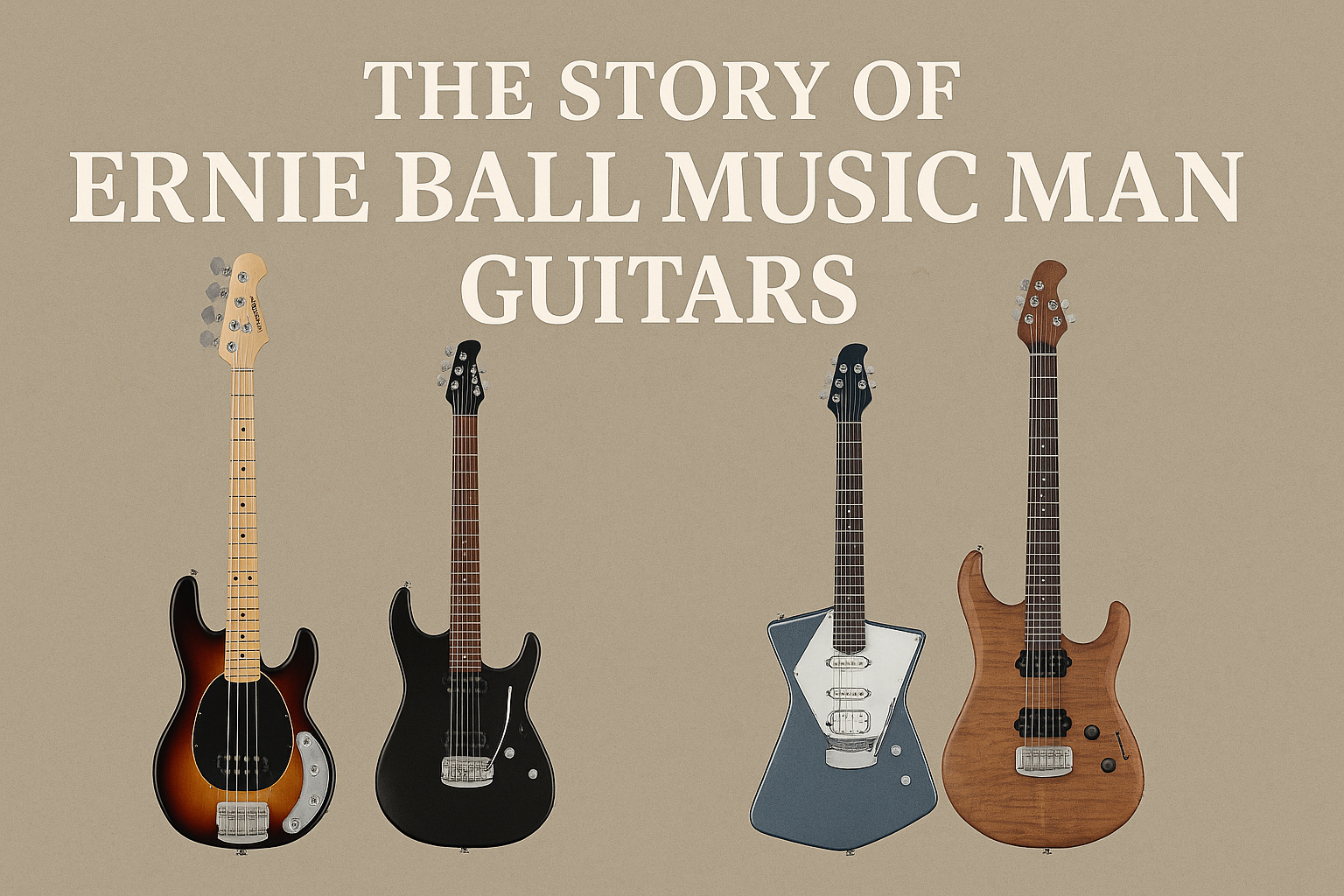When most people hear “Ernie Ball Music Man,” they probably think first of the StingRay bass — rightfully so. But the story behind the name, and how it evolved into a respected maker of both basses and guitars, is rich with design leaps, signature collaborations, and a lineage that links back to Leo Fender himself.
Early Roots: From Strings to Instruments
The “Ernie Ball” part of the name actually predates the instrument side by decades. Ernie Ball started his business in the 1950s, originally as a performer and retailer; he gained renown for pioneering custom-gauge guitar strings, notably his “Slinky” series, which set industry standards.
Meanwhile, the Music Man instrument company was formed in 1971 by Forrest White and Tom Walker, with Leo Fender acting as a silent partner. In 1974, Music Man began producing guitars and basses under its own name.
The two entities came together in 1984, when Ernie Ball Inc. purchased Music Man, and the brand was relaunched as Ernie Ball Music Man (EBMM). After the acquisition, EBMM focused heavily on improving consistency, production quality, and expanding both bass and guitar lines.
So, while the name combines two legacies, the instrument side really begins with Music Man but finds its fullest expression under Ernie Ball’s stewardship.
The Bass Legacy: The StingRay and Beyond
If you want a model that defines EBMM’s impact, the StingRay bass is at the top of the list.
The Original StingRay
-
Introduced in 1976 by Music Man, it was a bold rethinking of the electric bass. Instead of passive dual pickups, it featured a single oversized humbucker placed close to the bridge and active electronics (EQ) to shape tone.
-
Its tonal character was distinctive: more extended highs, scooped mids, strong lows — in part shaped by Leo Fender’s own hearing and tonal preferences.
-
The StingRay quickly found favour in funk, disco, and rock, with artists like Louis Johnson (of the Brothers Johnson), Bernard Edwards (Chic), and Paul Denman (Sade) among the early adopters.
Under Ernie Ball’s Ownership
After 1984, EBMM continued StingRay production, refined the design, and expanded the family:
-
They added body contours, new electronics (midrange EQ), and later 5-string versions (StingRay 5) in 1988.
-
Notable modern bassists embraced the StingRay: Flea (Red Hot Chili Peppers), Tim Commerford (Rage Against the Machine), Rex Brown (Pantera), Jeff Ament (Pearl Jam), Tony Levin, Jason Newsted, and many others.
-
The company also rolled out variants like the Bongo bass (a more modern, ergonomic alternative) and the scaled-down Sterling series (a lighter, slightly more compact StingRay derivative).
-
Recently (2025), EBMM launched a Pino Palladino signature StingRay, modelled after the fretless 1979 StingRay that helped define his sound.
Over time, the StingRay has come to be regarded as one of the major bass designs of the last few decades — both for its unique tonal voice and for the roster of players who helped bring it to prominence.
Guitar Side: Models, Innovations, and Signature Lines
While EBMM is often spotlighted for basses, it has also cultivated a respected guitar line, frequently collaborating with top-tier artists to produce instruments tailored for modern players.
Early Guitar Models: Sabre, Silhouette
-
In the late 1970s, Music Man introduced the Sabre I and Sabre II (circa 1977–1980). These were among the company’s first serious forays into electric guitar design.
-
Over the years, the guitar catalog expanded to include models like the Silhouette, which evolved in its specifications over time (bridge types, pickups, etc.)
Signature Collaborations & Flagship Models
Much of EBMM’s guitar identity is tied to its artist partnerships. Here are a few standout lines:
-
Steve Morse Signature
Introduced in 1987, the Steve Morse model is notable for its double-cutaway body, multiple pickup configurations (often with DiMarzio custom pickups), and versatile tonal switching. Morse’s ongoing involvement helps the guitar remain relevant across rock, country, and jazz styles.
-
John Petrucci / Majesty / JP Series
John Petrucci (Dream Theater) has had a long-standing partnership with EBMM. The Majesty model is marketed as a high-performance, modern instrument with features like advanced electronics, ergonomic body, and aesthetic flourishes. The JP15 is another variant in that family.
-
St. Vincent Signature
Annie Clark (St. Vincent) collaborated with EBMM to design a guitar optimized for her playing style — lightweight body, custom inlays, and distinctive pickup layout (three DiMarzio mini-humbuckers with 5-way switching).
-
James Valentine, Steve Lukather, Albert Lee, Jason Richardson, etc.
EBMM’s artist roster includes names across genres. For example, Lukather has a signature model with EBMM; so does Albert Lee (country/rock virtuoso).
-
Edward Van Halen Model
In 1991, EBMM introduced the Edward Van Halen signature guitar, which was Eddie’s first official signature instrument. The collaboration was fairly brief (early ’90s) but memorable, with design input from Van Halen himself.
-
Cutlass, Axis, Sabre (modern iterations)
Beyond artist models, EBMM offers non-signature models with modern features. For example, the Axis has gained acclaim as a flexible, responsive solidbody guitar. The Cutlass line emphasises classic form with modern tweaks.
Innovations, Craftsmanship & Philosophy
-
EBMM emphasises a combination of machine precision and handcraft — e.g. in fret installation, sanding, setup — to ensure consistency and high quality.
-
The factory in San Luis Obispo, California, is where many (though not all) instruments are built.
-
Serial number databases, archival models, and careful record-keeping reflect the company’s desire to maintain a historical lineage.
Notable Players & Their Instruments: A Snapshot
Here’s a sampling of well-known musicians and their associations with EBMM gear:
|
Artist |
Primary Model(s) / Signature |
Notes / Highlights |
|---|---|---|
|
John Petrucci |
Majesty, JP series |
Longtime signature collaboration; pushes modern performance design |
|
Steve Morse |
Steve Morse Signature |
Versatile design suitable across genres; strong EBMM presence since mid-1980s |
|
St. Vincent (Annie Clark) |
St. Vincent Signature |
Custom guitar reflecting her aesthetic & ergonomic preferences |
|
Steve Lukather |
Lukather Signature / EBMM model |
Part of the EBMM artist roster |
|
Albert Lee |
Lee Signature |
Country/rock guitar legend using EBMM instruments |
|
Louis Johnson |
StingRay bass |
Among earliest adopters; used the StingRay on seminal funk / disco recordings |
|
Bernard Edwards |
StingRay bass |
His foundational groove work (e.g. with Chic) was played on a StingRay |
|
Flea |
StingRay bass |
One of the modern rock ambassadors of the StingRay sound |
|
Tim Commerford |
StingRay bass |
Prominent user in alternative/rock genres |
|
Pino Palladino |
StingRay bass (signature) |
His fretless StingRay was pivotal in his sound; now has a signature model |
|
Edward Van Halen |
EVH Signature model |
His brief collaboration with EBMM in the early ’90s gave rise to the EVH guitar model |
This list is nowhere near exhaustive — EBMM’s catalog and artist ties cover many more names and styles.
Why EBMM Matters (Especially for Players)
-
Tonal Identity: Whether on bass or guitar, EBMM instruments tend to emphasise clarity, dynamic response, and modern voicings. Many players cite how the instrument “disappears under the fingers.”
-
Signature Credibility: Their artist models aren’t just name-plates — many are developed hand-in-hand with players and see real updates over time.
-
Craft + Consistency: Balancing automated precision with human oversight helps maintain high standards.
-
Evolutionist Approach: EBMM is not afraid to try new configurations: single-coil blends, midrange options, multi‑pickup switching, ergonomic body rethinks, etc.









